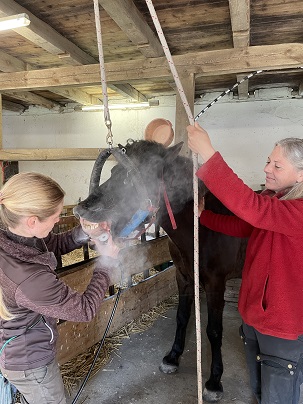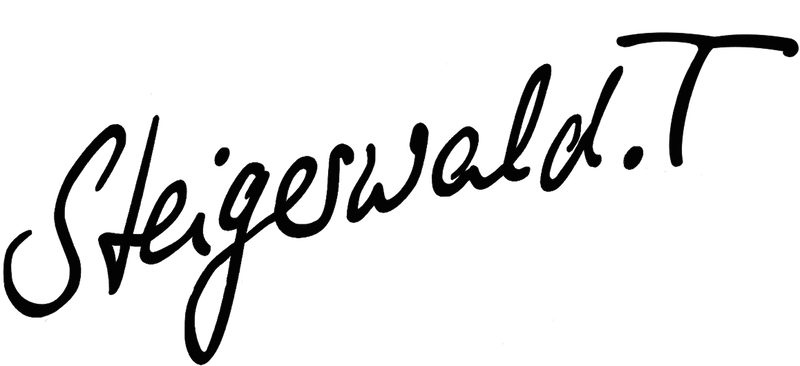Physical pain and its impact on behavior

I am Svea and currently the trainee at Hof Steigerwald.
Frekja is an Icelandic mare and 14 years young, I bought her in April 2020. She has a lively personality and used to have explosive reactions out of nowhere. Many of her actions were blamed on Frekja’s character. Even I never questioned it. When I started to train her differently with Nina and she was accustomed to the herd, the “overshooting” was noticeable and we thought about ways to help her. We tried to get Frekja more in balance with a Bach flower therapy and good training. But somehow there was a permanent tension in my horse that was just normal to me. That was Frekja. An explosive horse. Physical causes for behavior did not occur to me.
The previous owner had her teeth checked every year. Apart from a few edges, nothing was ever discovered. Last year, on her scheduled dental check-up date, we were going to Hof Steigerwald. “No problem,” I thought. “Nothing has ever been discovered, so it’s okay if the check-up is after 1.5 years and not after one as usual.”
In May, Rebecca Pflug came for her dental appointment. I was really excited because I’ve never seen anything like this and I’ve never experienced a sedated horse. But Rebecca was great and after a few minutes into her treatment she discovered something not so good in my horses jaw: the upper first, right molar tooth was split transversely. A broken tooth in my horse’s jaw! That was the first shocking surprise. One possible cause: The first lower molar teeth on both sides were too long and had therefore put too much pressure on the upper ones. On the left side it was not sure if the first upper molar tooth was also broken or if it was just a wolf tooth that had placed itself strangely. In any case, it was clear: the broken tooth has to be removed.
Okay, what now? Since my horse doesn’t go well on a trailer, I wanted to hike back to Hamburg with her. The trip was planned for the end of May/beginning of June. One tooth has to be pulled, that’s only a small intervention, not that big of a deal for most horses, so maybe it can be combined? On the way home, we stop at the Ottersberg clinic, take a little break to recover, and keep on hiking. That was the plan. A crazy plan, but I’m still young and therefor still allowed to make such plans.
The operation was on 1 June. On the third day of our trip we arrived at the clinic and my horse was sedated straight away, because she didn’t feel comfortable in the treatment room and without sedation the first examination of the teeth wouldn’t have been possible.
It soon became clear that both teeth were broken. The other supposed to be wolf tooth was part of the molar tooth that had been broken into three pieces. After the X-ray, the next surprise: On the right side, there was a granuloma above the broken tooth. According to the vets, this nodular, inflammatory collection of cells had been growing for about 2 years. For this period of time a flammable process had been going on in my horse’s mouth, making the two teeth unstable and dissolving the roots. My horse must have been in more or less severe pain for at least a year. The surgery was scheduled for 1.5 hours.
Unfortunately, I was not allowed to be present during her operation. I was completely exhausted and organised a pick-up service for us, as it was no longer possible to walk any further. At 12 o’clock sharp I was standing in front of the treatment room, the trailer was already there and I am still incredibly grateful for my host Ulrike for her support and how warmly she took Frekja and I in.
The two of us sat in front of the treatment room, but still no doctor came out.
At 12.15 pm I was told that the operation would still take a while. The granuloma had moved in the wrong direction, they were still trying to remove it. Shortly afterwards I heard someone calling for help from the room, but I didn’t know what was going on. Terrible! At about 12:45 I heard people cheering in the room, and at 1pm I was finally allowed to come inside to see my horse. The surgery took 2.5 hours in total, there were 5 people there at the end, trying to remove the granuloma through nose and jaw. With success!
She was given an antibiotic for 7 days and painkillers for about 4 days. On Thursday we did the follow-up examination and changed the swab. Nina and Mario picked us up with Amadeus so that she wouldn’t have to stand alone on the hated trailer. When Nina saw Frekja for the first time after the operation, she noticed Frekja’s relaxed facial expression. On the second day without painkillers, I was completely panicking that she might still be in pain because she was so unusually calm. But when I saw her cuddling with Braunchen for the first time, I realised that she was probably pain free for the first time in maybe years.
Frekja has a much softer facial expression ever since the operation and also seems more relaxed in other ways. I am so happy and relieved that Rebecca saw these teeth and recommended to me the Ottersberg clinic. I felt very comfortable there and Frekja’s wounds are healing very well.
This story made me realise how important it is to have an annual and thorough dental check-up. Teeth affect so much and sometimes you don’t realise it as the owner. Frekja always cooperated, she was motivated, she ate. Nothing seemed to be wrong with her. There was just this general tension that was part of package deal, but the difference to now is enormous.
Please, please, please have your horses examined regularly!
I wouldn’t want any horse to go through such a thing. If I had taken the teeth more seriously, I could`ve helped Frekja much sooner.
Now, I’m going to focus on medical training. Fortunately, Nina has described all necessary steps for dental training in her new book “Medical Training for Horses” and in the webinar “Dental Training”. Because in addition to the broken teeth, Frekja also has cavities on two teeth and gum recession on her front teeth. Oh well, life with a horse never gets boring.
Have you ever had a bad surprise at a dental check-up?
